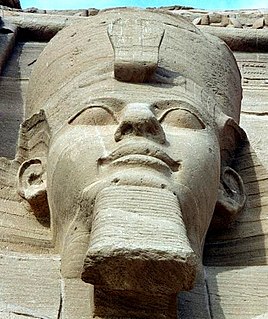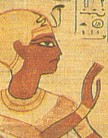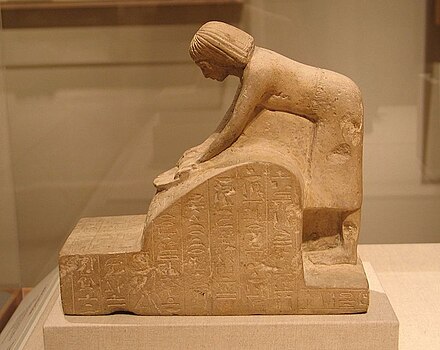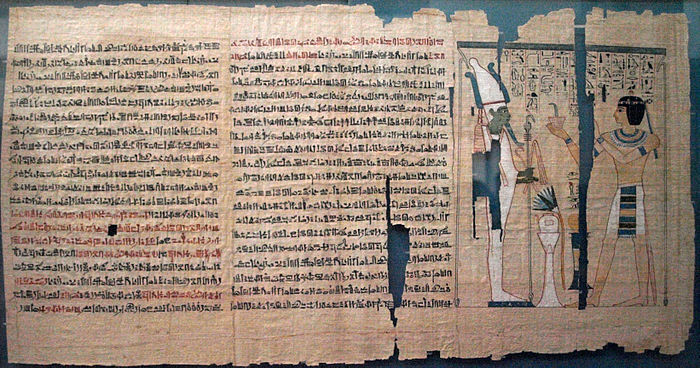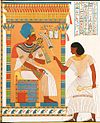
Thebes, known to the ancient Egyptians as Waset, was an ancient Egyptian city located along the Nile about 800 kilometers (500 mi) south of the Mediterranean. Its ruins lie within the modern Egyptian city of Luxor. Thebes was the main city of the fourth Upper Egyptian nome and was the capital of Egypt mainly during the Middle Kingdom and the New Kingdom. It was close to Nubia and the Eastern Desert, with its valuable mineral resources and trade routes. It was a cult center and the most venerated city of ancient Egypt during its heyday. The site of Thebes includes areas on both the eastern bank of the Nile, where the temples of Karnak and Luxor stand and the city proper was situated; and the western bank, where a necropolis of large private and royal cemeteries and funerary complexes can be found.

Amunet is a primordial goddess in ancient Egyptian religion.

Shebitku was the second king of the Twenty-fifth Dynasty of Egypt who ruled from 714 BC-705 BC, according to the most recent academic research. He was a son of Piye, the founder of this dynasty. Shebitku's prenomen or throne name, Djedkare, means "Enduring is the Soul of Re." Shebitku's queen was Arty, who was a daughter of king Piye, according to a fragment of statue JE 49157 of the High Priest of Amun Haremakhet, son of Shabaka, found in the temple of the Goddess Mut in Karnak.

Titkheperure or Tyetkheperre Psusennes II [Greek Ψουσέννης] or Hor-Pasebakhaenniut II [Egyptian ḥr-p3-sb3-ḫˁỉ-<n>-nỉwt], was the last king of the Twenty-first dynasty of Egypt. His royal name means "Image of the transformations of Re" in Egyptian. Psusennes II is often considered the same person as the High-Priest of Amun known as Psusennes III. The Egyptologist Karl Jansen-Winkeln notes that an important graffito from the Temple of Abydos contains the complete titles of a king Tyetkheperre Setepenre Pasebakhaenniut Meryamun "who is simultaneously called the HPA and supreme military commander." This suggests that Psusennes was both king at Tanis and the High Priest in Thebes at the same time, meaning he did not resign his office as High Priest of Amun during his reign. The few contemporary attestations from his reign include the aforementioned graffito in Seti I's Abydos temple, an ostracon from Umm el-Qa'ab, an affiliation at Karnak and his presumed burial – which consists of a gilded coffin with a royal uraeus and a Mummy, found in an antechamber of Psusennes I's tomb at Tanis. He was a High Priest of Amun at Thebes and the son of Pinedjem II and Istemkheb. His daughter Maatkare B was the Great Royal Wife of Osorkon I.

Pinedjem I was the High Priest of Amun at Thebes in Ancient Egypt from 1070 to 1032 BC and the de facto ruler of the south of the country from 1054 BC. He was the son of the High Priest Piankh. However, many Egyptologists today believe that the succession in the Amun priesthood actually ran from Piankh to Herihor to Pinedjem I.

Menkheperre, son of Pharaoh Pinedjem I by wife Duathathor-Henuttawy, was the High Priest of Amun at Thebes in Ancient Egypt from 1045 BC to 992 BC and de facto ruler of the south of the country.

The Divine Adoratrice of Amun was a second title – after God's Wife of Amun – created for the chief priestess of the ancient Egyptian deity, Amun. During the first millennium BCE, when the holder of this office exercised her largest measure of influence, her position was an important appointment facilitating the transfer of power from one pharaoh to the next, when his daughter was adopted to fill it by the incumbent office holder. The Divine Adoratrice ruled over the extensive temple duties and domains, controlling a significant part of the ancient Egyptian economy.

God's Wife of Amun was the highest-ranking priestess of the Amun cult, an important religious institution in ancient Egypt. The cult was centered in Thebes in Upper Egypt during the Twenty-fifth and Twenty-sixth dynasties. The office had political importance as well as religious, since the two were closely related in ancient Egypt.

The necropolis of El-Khokha is located on the west bank of the river Nile at Thebes, Egypt. The necropolis is surrounds a hill and has five Old Kingdom tombs and over 50 tombs from the 18th, 19th and 20th dynasties as well as some from the first intermediate period and the late period.
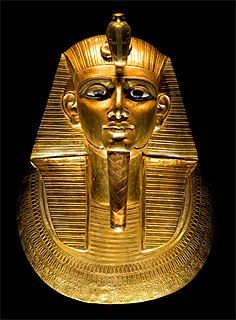
Psusennes I was the third pharaoh of the 21st Dynasty who ruled from Tanis between 1047–1001 BC. Psusennes is the Greek version of his original name Pasibkhanu or Pasebakhaenniut, which means "The Star Appearing in the City" while his throne name, Akheperre Setepenamun, translates as "Great are the Manifestations of Ra, chosen of Amun." He was the son of Pinedjem I and Henuttawy, Ramesses XI's daughter by Tentamun. He married his sister Mutnedjmet.

Hedjkheperre Setepenre Smendes was the founder of the Twenty-first dynasty of Egypt and succeeded to the throne after burying Ramesses XI in Lower Egypt – territory which he controlled. His Egyptian nomen or birth name was actually Nesbanebdjed meaning "He of the Ram, Lord of Mendes", but it was translated into Greek as Smendes by later classical writers such as Josephus and Sextus Africanus. While Smendes' precise origins remain a mystery, he is thought to have been a powerful governor in Lower Egypt during the Renaissance era of Ramesses XI and his base of power was Tanis.

Neterkheperre or Netjerkheperre-Setepenamun Siamun was the sixth pharaoh of Egypt during the Twenty-first dynasty. He built extensively in Lower Egypt for a king of the Third Intermediate Period and is regarded as one of the most powerful rulers of the 21st Dynasty after Psusennes I. Siamun's prenomen, Netjerkheperre-Setepenamun, means "Divine is The Manifestation of Ra, Chosen of Amun" while his name means 'son of Amun.'
While not regarded as a dynasty, the High Priests of Amun at Thebes were nevertheless of such power and influence that they were effectively the rulers of Upper Egypt from 1080 to c. 943 BC, after which their influence declined. By the time Herihor was proclaimed as the first ruling High Priest of Amun in 1080 BC—in the 19th Year of Ramesses XI—the Amun priesthood exercised an effective stranglehold on Egypt's economy. The Amun priests owned two-thirds of all the temple lands in Egypt and 90 percent of her ships plus many other resources. Consequently, the Amun priests were as powerful as the Pharaoh, if not more so. One of the sons of the High Priest Pinedjem I would eventually assume the throne and rule Egypt for almost half a decade as pharaoh Psusennes I, while the Theban High Priest Psusennes III would take the throne as king Psusennes II, the final ruler of the Twenty-first Dynasty of Egypt.

Masaharta or Masaherta was the High Priest of Amun at Thebes between 1054 and 1045 BC.

Pinedjem II was a High Priest of Amun at Thebes in Ancient Egypt from 990 BC to 969 BC and was the de facto ruler of the south of the country. He was married to his sister Isetemkheb D and also to his niece Nesikhons, the daughter of his brother Smendes II. He succeeded Smendes II, who had a short rule.

Haremakhet, also Horemakhet or Harmakhis, was an ancient Egyptian prince and High Priest of Amun during the 25th Dynasty.







